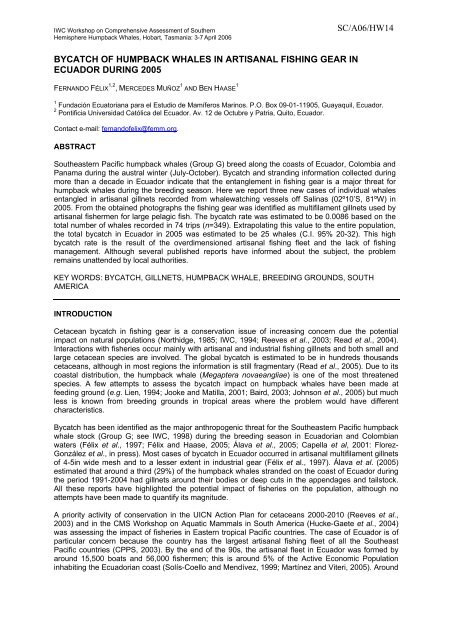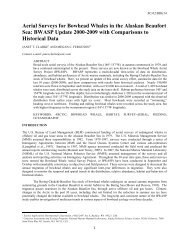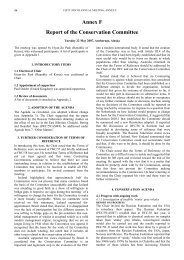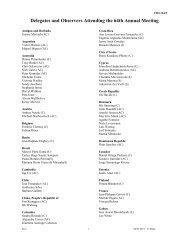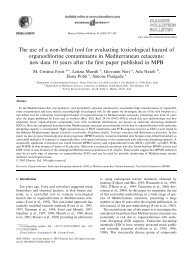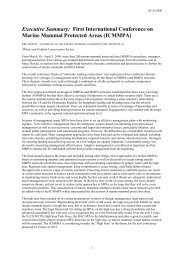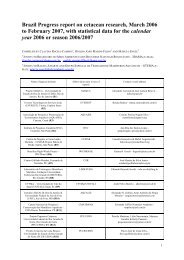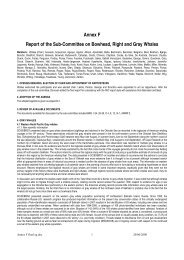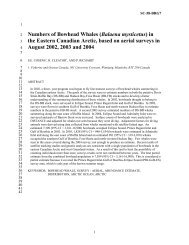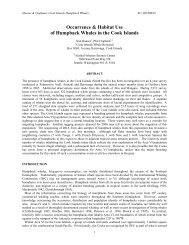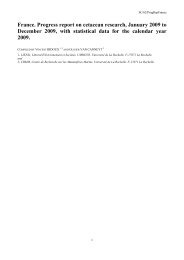bycatch of humpback whales in artisanal fishing gear in ecuador ...
bycatch of humpback whales in artisanal fishing gear in ecuador ...
bycatch of humpback whales in artisanal fishing gear in ecuador ...
Create successful ePaper yourself
Turn your PDF publications into a flip-book with our unique Google optimized e-Paper software.
IWC Workshop on Comprehensive Assessment <strong>of</strong> Southern<br />
Hemisphere Humpback Whales, Hobart, Tasmania: 3-7 April 2006<br />
BYCATCH OF HUMPBACK WHALES IN ARTISANAL FISHING GEAR IN<br />
ECUADOR DURING 2005<br />
FERNANDO FÉLIX 1,2 , MERCEDES MUÑOZ 1 AND BEN HAASE 1<br />
1 Fundación Ecuatoriana para el Estudio de Mamíferos Mar<strong>in</strong>os. P.O. Box 09-01-11905, Guayaquil, Ecuador.<br />
2 Pontificia Universidad Católica del Ecuador. Av. 12 de Octubre y Patria, Quito, Ecuador.<br />
Contact e-mail: fernand<strong>of</strong>elix@femm.org.<br />
ABSTRACT<br />
Southeastern Pacific <strong>humpback</strong> <strong>whales</strong> (Group G) breed along the coasts <strong>of</strong> Ecuador, Colombia and<br />
Panama dur<strong>in</strong>g the austral w<strong>in</strong>ter (July-October). Bycatch and strand<strong>in</strong>g <strong>in</strong>formation collected dur<strong>in</strong>g<br />
more than a decade <strong>in</strong> Ecuador <strong>in</strong>dicate that the entanglement <strong>in</strong> fish<strong>in</strong>g <strong>gear</strong> is a major threat for<br />
<strong>humpback</strong> <strong>whales</strong> dur<strong>in</strong>g the breed<strong>in</strong>g season. Here we report three new cases <strong>of</strong> <strong>in</strong>dividual <strong>whales</strong><br />
entangled <strong>in</strong> <strong>artisanal</strong> gillnets recorded from whalewatch<strong>in</strong>g vessels <strong>of</strong>f Sal<strong>in</strong>as (02º10’S, 81ºW) <strong>in</strong><br />
2005. From the obta<strong>in</strong>ed photographs the fish<strong>in</strong>g <strong>gear</strong> was identified as multifilament gillnets used by<br />
<strong>artisanal</strong> fishermen for large pelagic fish. The <strong>bycatch</strong> rate was estimated to be 0.0086 based on the<br />
total number <strong>of</strong> <strong>whales</strong> recorded <strong>in</strong> 74 trips (n=349). Extrapolat<strong>in</strong>g this value to the entire population,<br />
the total <strong>bycatch</strong> <strong>in</strong> Ecuador <strong>in</strong> 2005 was estimated to be 25 <strong>whales</strong> (C.I. 95% 20-32). This high<br />
<strong>bycatch</strong> rate is the result <strong>of</strong> the overdimensioned <strong>artisanal</strong> fish<strong>in</strong>g fleet and the lack <strong>of</strong> fish<strong>in</strong>g<br />
management. Although several published reports have <strong>in</strong>formed about the subject, the problem<br />
rema<strong>in</strong>s unattended by local authorities.<br />
KEY WORDS: BYCATCH, GILLNETS, HUMPBACK WHALE, BREEDING GROUNDS, SOUTH<br />
AMERICA<br />
INTRODUCTION<br />
SC/A06/HW14<br />
Cetacean <strong>bycatch</strong> <strong>in</strong> fish<strong>in</strong>g <strong>gear</strong> is a conservation issue <strong>of</strong> <strong>in</strong>creas<strong>in</strong>g concern due the potential<br />
impact on natural populations (Northidge, 1985; IWC, 1994; Reeves et al., 2003; Read et al., 2004).<br />
Interactions with fisheries occur ma<strong>in</strong>ly with <strong>artisanal</strong> and <strong>in</strong>dustrial fish<strong>in</strong>g gillnets and both small and<br />
large cetacean species are <strong>in</strong>volved. The global <strong>bycatch</strong> is estimated to be <strong>in</strong> hundreds thousands<br />
cetaceans, although <strong>in</strong> most regions the <strong>in</strong>formation is still fragmentary (Read et al., 2005). Due to its<br />
coastal distribution, the <strong>humpback</strong> whale (Megaptera novaeangliae) is one <strong>of</strong> the most threatened<br />
species. A few attempts to assess the <strong>bycatch</strong> impact on <strong>humpback</strong> <strong>whales</strong> have been made at<br />
feed<strong>in</strong>g ground (e.g. Lien, 1994; Jooke and Matilla, 2001; Baird, 2003; Johnson et al., 2005) but much<br />
less is known from breed<strong>in</strong>g grounds <strong>in</strong> tropical areas where the problem would have different<br />
characteristics.<br />
Bycatch has been identified as the major anthropogenic threat for the Southeastern Pacific <strong>humpback</strong><br />
whale stock (Group G; see IWC, 1998) dur<strong>in</strong>g the breed<strong>in</strong>g season <strong>in</strong> Ecuadorian and Colombian<br />
waters (Félix et al., 1997; Félix and Haase, 2005; Álava et al., 2005; Capella et al, 2001: Florez-<br />
González et al., <strong>in</strong> press). Most cases <strong>of</strong> <strong>bycatch</strong> <strong>in</strong> Ecuador occurred <strong>in</strong> <strong>artisanal</strong> multifilament gillnets<br />
<strong>of</strong> 4-5<strong>in</strong> wide mesh and to a lesser extent <strong>in</strong> <strong>in</strong>dustrial <strong>gear</strong> (Félix et al., 1997). Álava et al. (2005)<br />
estimated that around a third (29%) <strong>of</strong> the <strong>humpback</strong> <strong>whales</strong> stranded on the coast <strong>of</strong> Ecuador dur<strong>in</strong>g<br />
the period 1991-2004 had gillnets around their bodies or deep cuts <strong>in</strong> the appendages and tailstock.<br />
All these reports have highlighted the potential impact <strong>of</strong> fisheries on the population, although no<br />
attempts have been made to quantify its magnitude.<br />
A priority activity <strong>of</strong> conservation <strong>in</strong> the UICN Action Plan for cetaceans 2000-2010 (Reeves et al.,<br />
2003) and <strong>in</strong> the CMS Workshop on Aquatic Mammals <strong>in</strong> South America (Hucke-Gaete et al., 2004)<br />
was assess<strong>in</strong>g the impact <strong>of</strong> fisheries <strong>in</strong> Eastern tropical Pacific countries. The case <strong>of</strong> Ecuador is <strong>of</strong><br />
particular concern because the country has the largest <strong>artisanal</strong> fish<strong>in</strong>g fleet <strong>of</strong> all the Southeast<br />
Pacific countries (CPPS, 2003). By the end <strong>of</strong> the 90s, the <strong>artisanal</strong> fleet <strong>in</strong> Ecuador was formed by<br />
around 15,500 boats and 56,000 fishermen; this is around 5% <strong>of</strong> the Active Economic Population<br />
<strong>in</strong>habit<strong>in</strong>g the Ecuadorian coast (Solís-Coello and Mendívez, 1999; Martínez and Viteri, 2005). Around
50% <strong>of</strong> the fleet uses multifilament gillnets <strong>of</strong> 4-5” wide mesh up to 3km <strong>in</strong> length as ma<strong>in</strong> <strong>gear</strong> to<br />
catch large pelagic fish (sharks and billfish) (Martínez et al. 1991).<br />
Here we present new cases <strong>of</strong> <strong>humpback</strong> <strong>whales</strong> entangled <strong>in</strong> <strong>artisanal</strong> gillnets found <strong>of</strong>f Sal<strong>in</strong>as,<br />
Ecuador (2º10’S, 81º’W) (Figure 1). In contrast to previously reported beach<strong>in</strong>gs, these new cases<br />
<strong>in</strong>volved live <strong>whales</strong>. The new approach allowed estimat<strong>in</strong>g the magnitude <strong>of</strong> the total <strong>bycatch</strong> at<br />
tak<strong>in</strong>g <strong>in</strong>to account the survey effort <strong>of</strong> the season.<br />
METHODS<br />
Figure 1. The study area located at Sal<strong>in</strong>as, Ecuador.<br />
Whalewatch<strong>in</strong>g boats have been used as research platform dur<strong>in</strong>g a long-term study <strong>of</strong> the<br />
<strong>humpback</strong> whale <strong>in</strong> Ecuador (see Félix and Haase, 2001a for details). Data analyzed <strong>in</strong> this report<br />
was obta<strong>in</strong>ed dur<strong>in</strong>g the breed<strong>in</strong>g season 2005 (late June-early October). Seven different boats were<br />
used with size rang<strong>in</strong>g between 7 and 15 m <strong>in</strong> length and 10-30 passengers <strong>of</strong> capacity. Usually<br />
boats departed at 9:00 <strong>in</strong> the morn<strong>in</strong>g and last<strong>in</strong>g two or three hours. Occasionally trips were also<br />
made <strong>in</strong> the afternoon. Dur<strong>in</strong>g the trips, <strong>in</strong>formation on survey effort, oceanographic conditions, whale<br />
behaviour, head<strong>in</strong>g, group size and composition was filled out on data forms. As a standard<br />
methodology, <strong>whales</strong> were photographed with a Canon Rebel Digital camera (6.3 megapixels)<br />
equipped with a 70-300mm zoom lens for <strong>in</strong>dividual identification.<br />
RESULTS<br />
Effort<br />
Seventy four trips were made between 27 th June and 1 st October 2005. A total <strong>of</strong> 349 <strong>whales</strong> <strong>in</strong> 148<br />
groups were recorded. Total navigation time was 156 hours, <strong>of</strong> which 59 hours were spent with the<br />
<strong>whales</strong>. The surveyed distance was 2,031km. Table 1 shows the monthly effort deployed through the<br />
season. July and August were the months with the largest effort with trips almost everyday and then<br />
the effort decreased considerably <strong>in</strong> September when tourist activities also decreased.<br />
2
Table 1. Research effort by month. Period (June-October 2005).<br />
June July August September October Total<br />
Number <strong>of</strong> trips 4 33 33 3 1 74<br />
Number <strong>of</strong> groups sighted 5 75 64 4 - 148<br />
Number <strong>of</strong> <strong>whales</strong> 10 174 155 10 - 349<br />
Observation time (m<strong>in</strong>) 268 1,729 1,434 112 - 3,543<br />
Net navigation time (m<strong>in</strong>) 277 2,348 2,723 342 - 5,690<br />
Total navigation time (m<strong>in</strong>) 545 4,077 4,157 454 143 9,376<br />
Distance surveyed (km) 120 924 866 89 31 2,031<br />
The Cases<br />
Three entangled <strong>whales</strong> were recorded dur<strong>in</strong>g the trips <strong>in</strong> the season 2005: June 26, August 10 and<br />
August 11. All three cases <strong>in</strong>volved adult animals. Photographs <strong>of</strong> the dorsal f<strong>in</strong> <strong>in</strong>dicated that <strong>whales</strong><br />
were different <strong>in</strong>dividuals. S<strong>in</strong>ce only the back <strong>of</strong> the <strong>whales</strong> was visible dur<strong>in</strong>g the encounters, it was<br />
not possible to determ<strong>in</strong>e the seriousness <strong>in</strong> each case and if the whale had the chance to get rid <strong>of</strong><br />
the net (Figure 2). The whale found <strong>in</strong> June had the net around the anterior part <strong>of</strong> the body <strong>in</strong>clud<strong>in</strong>g<br />
the head, but apparently the tail was free; however, a long strip <strong>of</strong> net with yellow floaters showed the<br />
whale was tow<strong>in</strong>g several meters <strong>of</strong> <strong>gear</strong>. The <strong>in</strong>dividual found <strong>in</strong> August 10 was a female with a<br />
newborn calf seen for short time; <strong>in</strong> this case, apparently only the adult animal was seen with a net a<br />
long the side <strong>of</strong> the body. The case <strong>of</strong> August 11 did not directly look fatal, s<strong>in</strong>ce just the part <strong>of</strong> a net<br />
was around the central part <strong>of</strong> the back and the dorsal f<strong>in</strong>, although also flippers and the tail could be<br />
entangled.<br />
The whale found <strong>in</strong> June moved slowly and stayed around the same area but it was evident along the<br />
observation period that the net impacted and slowed down its movements. In contrast, the other two<br />
cases <strong>whales</strong> apparently moved without problems. In the first and second cases <strong>whales</strong> moved a few<br />
hundred meters from shore <strong>of</strong>f the Sal<strong>in</strong>as tip, but the third whale was recorded 2-3 km north <strong>of</strong> this<br />
po<strong>in</strong>t.<br />
Figure 2. Whales found entangled dur<strong>in</strong>g the season 2005 <strong>of</strong>f Sal<strong>in</strong>as: June 26 (top); August 10<br />
(middle); and August 11 (bottom).<br />
3
Bycatch rate and total mortality<br />
Consider<strong>in</strong>g the total number <strong>of</strong> <strong>whales</strong> recorded (n=349) and the three <strong>whales</strong> found entangled, a<br />
<strong>bycatch</strong> rate <strong>of</strong> 0.0086 was calculated. Extrapolat<strong>in</strong>g this value to the entire population estimated to<br />
be 2,917 animals <strong>in</strong> the period 2003-2004 (Félix et al., 2006), around 25 <strong>whales</strong> (C.I. 95% 20-32)<br />
could be the total <strong>bycatch</strong> <strong>in</strong> the breed<strong>in</strong>g season 2005 <strong>in</strong> Ecuador.<br />
DISCUSSION<br />
The entanglement <strong>of</strong> <strong>humpback</strong> <strong>in</strong> <strong>artisanal</strong> gillnets <strong>in</strong> Ecuador cont<strong>in</strong>ued <strong>in</strong> 2005 likely with similar<br />
<strong>in</strong>tensity as previous years. Besides the three cases reported here, the authors knew <strong>of</strong> two other<br />
cases which occurred <strong>in</strong> other parts <strong>of</strong> the country <strong>in</strong>volv<strong>in</strong>g beached <strong>whales</strong> with gillnets around their<br />
bodies. Also, sailors and naturalist guides reported entangled <strong>whales</strong> <strong>of</strong>f Sal<strong>in</strong>as every year s<strong>in</strong>ce<br />
whalewatch<strong>in</strong>g started here <strong>in</strong> 2001; at least three cases were reported <strong>in</strong> 2003 (Félix and Haase,<br />
2003). Other cases <strong>of</strong> entanglements were reported at La Plata Island, 100km north <strong>of</strong> Sal<strong>in</strong>as, a calf<br />
<strong>in</strong> 1998 (Scheidat et al., 2000) and six adults or sub-adults animals <strong>in</strong> 2001 (Álava et al., 2005).<br />
It is believed that the entanglement <strong>of</strong> <strong>humpback</strong> <strong>whales</strong> <strong>in</strong> <strong>artisanal</strong> gillnets <strong>in</strong> Ecuador and Colombia<br />
have ma<strong>in</strong>ta<strong>in</strong>ed an <strong>in</strong>creas<strong>in</strong>g trend <strong>in</strong> the last decade (Capella et al., 2001; Álava et al., 2005), but<br />
there not pro<strong>of</strong> as no reliable assessments have been made. So far, data on beached animals have<br />
provided a gross idea <strong>of</strong> the <strong>bycatch</strong> level but not its magnitude, s<strong>in</strong>ce not every entangled or dead<br />
whale ended up on the beach. Our estimate provides a first approach to establish the total <strong>bycatch</strong> <strong>in</strong><br />
Ecuador by us<strong>in</strong>g a measurable search<strong>in</strong>g effort and therefore allow<strong>in</strong>g extrapolation for the entire<br />
population that reach Ecuador. However, it is not possible to establish the impact on the population<br />
s<strong>in</strong>ce no data on survival after the entanglement are available. Photographs <strong>of</strong> the animals found <strong>of</strong>f<br />
Sal<strong>in</strong>as <strong>in</strong> 2005 showed different level <strong>of</strong> seriousness with likely different survival chances for the<br />
<strong>whales</strong>; therefore, it is not possible to obta<strong>in</strong> an overall rate.<br />
The fate <strong>of</strong> the entangled <strong>whales</strong> was unknown, but previous records <strong>of</strong> stranded animals on the<br />
coast <strong>of</strong> Ecuador suggest that at least some <strong>whales</strong> die few weeks later after the entanglement (e.g.<br />
Félix et al, 1997; Álava et al, 2005). These animals would die <strong>of</strong> exhaustion or would be easy preyed<br />
upon by orcas and big sharks at sea. In the female with calf case (#2), the impact would be even<br />
bigger, s<strong>in</strong>ce calves also would die afterwards. Whatever the proportion <strong>of</strong> animals dy<strong>in</strong>g as a<br />
consequence <strong>of</strong> the entanglement, it may have a significant impact <strong>in</strong> the recovery <strong>of</strong> this population.<br />
S<strong>in</strong>ce both fish<strong>in</strong>g effort and whale population are <strong>in</strong>creas<strong>in</strong>g <strong>in</strong> Ecuador (see Félix et al, 2006), it is<br />
expected that the number <strong>of</strong> entangled <strong>whales</strong> will cont<strong>in</strong>ue <strong>in</strong>creas<strong>in</strong>g <strong>in</strong> the future if measurements<br />
are not taken on short-terms. Several management actions have been proposed by Ecuadorian<br />
researches <strong>in</strong> order to reduce the level <strong>of</strong> cetacean <strong>bycatch</strong>, <strong>in</strong>clud<strong>in</strong>g directed research; education<br />
programs for <strong>artisanal</strong> fishermen; use <strong>of</strong> sound devices; closed seasons; change <strong>of</strong> fish<strong>in</strong>g <strong>gear</strong>;<br />
creation <strong>of</strong> rescue teams; among others (Félix and Samaniego, 2004; Félix et al, 1997; Álava et al,<br />
2005; Félix and Haase, 2005). Some <strong>of</strong> these measures could be implemented on a temporary basis<br />
dur<strong>in</strong>g the <strong>humpback</strong> whale breed<strong>in</strong>g season or <strong>in</strong> specific sites <strong>of</strong> higher density <strong>of</strong> <strong>whales</strong>. With<br />
exception <strong>of</strong> a limited number <strong>of</strong> educative talks dur<strong>in</strong>g the seasons 2002 and 2003 no other actions<br />
have been taken by fish<strong>in</strong>g authorities.<br />
Consider<strong>in</strong>g that such high <strong>bycatch</strong> rate <strong>of</strong> a long-migrat<strong>in</strong>g species as the <strong>humpback</strong> whale has<br />
transboundary implicitness, we ask to the Scientific Committee <strong>of</strong> the International Whal<strong>in</strong>g<br />
Commission to urge Ecuadorian authorities the adoption <strong>of</strong> measures to reduce the level <strong>of</strong> <strong>bycatch</strong><br />
on short-term. We also recommend that any proposal and or decision to be taken to address the<br />
<strong>bycatch</strong> problem must be agreed with relevant stakeholders <strong>in</strong>clud<strong>in</strong>g fish<strong>in</strong>g authorities, <strong>artisanal</strong><br />
fishermen associations, NGOs, among others.<br />
ACKNOWLEDGEMENTS<br />
We thank tourist operators <strong>in</strong> Sal<strong>in</strong>as who allowed us us<strong>in</strong>g their vessels for this study. The <strong>humpback</strong><br />
whale research <strong>in</strong> Ecuador is supported by the Whale and Dolph<strong>in</strong> Conservation Society (WDCS).<br />
4
REFERENCES<br />
Álava, J. J., Barragán, M., Castro, C. and Carvajal, R. 2005. A note on strand<strong>in</strong>gs and entanglements <strong>of</strong> <strong>humpback</strong><br />
<strong>whales</strong> (Megaptera novaeangliae) <strong>in</strong> Ecuador. J. Cetacean Res. Manage. 7(2):163-168.<br />
Baird, R. W. 2003. Update COSEWIC status report on the <strong>humpback</strong> whale Megaptera novaeangliae <strong>in</strong> Canada. In<br />
COSEWIC Assessment and update status report on the Humpback Whale Megaptera novaeangliae <strong>in</strong> Canada.<br />
Committee on the Status <strong>of</strong> Endangered Wildlife <strong>in</strong> Canada. Ottawa. 25 p.<br />
Capella, J., Flórez-González, J. and Fernández, P. 2001. Mortality and anthropogenic harassment <strong>of</strong> <strong>humpback</strong><br />
<strong>whales</strong> along the Pacific coast <strong>of</strong> Colombia. Memoirs <strong>of</strong> the Queensland Museum, 4782):547-553.<br />
Comisión Permanente del Pacífico Sur (CPPS). 2003. Estudio sobre el impacto socioeconómico de la pesca<br />
artesanal en los estados miembros de la Comisión Permanente del Pacífico Sur. Guayaquil, Ecuador. 37 p. (In<br />
Spanish).<br />
Félix, F. and Samaniego, J. 1994. Incidental catches <strong>of</strong> small cetaceans <strong>in</strong> the <strong>artisanal</strong> fisheries <strong>of</strong> Ecuador. Rep.<br />
Int. Whal. Commn. (Special Issue 15). Pp 475-480.<br />
Félix, F. and Haase, B. 2003. Humpback whale research and education activities <strong>in</strong> Ecuador dur<strong>in</strong>g 2003. Report<br />
to the Whale and Dolph<strong>in</strong> Society WDCS, England. Guayaquil, December 2003. 27p.<br />
Félix, F. and Haase, B. 2005. Distribution <strong>of</strong> <strong>humpback</strong> <strong>whales</strong> along the coast <strong>of</strong> Ecuador and management<br />
implications. Journal <strong>of</strong> Cetacean Research and Management. Vol. 7(1):21-31.<br />
Félix, F., Haase, B., Davis, J. W., Chiluiza, D. and Amador, P. 1997. A note on recent strand<strong>in</strong>gs and <strong>bycatch</strong>es <strong>of</strong><br />
sperm <strong>whales</strong> (Physeter macrocephalus) and <strong>humpback</strong> <strong>whales</strong> (Megaptera novaeangliae) <strong>in</strong> Ecuador. Rep.<br />
Int. Whal. Commn. Vol. 47:917-919.<br />
Félix, F., Castro, C., Haase, B., Forestell, P., Álava, J. J., and Scheidat, M. 2006. Estimates <strong>of</strong> the Southeastern<br />
Pacific <strong>humpback</strong> whale stock with mark-recapture models <strong>in</strong> Ecuador. Document SC/A06/HW13 presented<br />
<strong>in</strong> the IWC Workshop on Comprehensive Assessment <strong>of</strong> Southern Hemisphere Humpback Whales, Hobart,<br />
Tasmania: 3-7 April 2006. 7p.<br />
Flórez, L., Capella, J., Falk, P., Félix, F., Gibbons, J., Haase, B., Santillán, L., Peña, V., Ávila, I., Herrera, J.,<br />
Tobón, I. and Van Waerebeek, K. (In press) Estrategia para la Conservación de la Ballena Jorobada del<br />
Pacífico Sudeste. Universidad de Magallanes, Chile.<br />
Hucke-Gaete, R., Crespo, E., and Schlatter, R. (Eds). 2004. Aquatic mammals <strong>in</strong> Lat<strong>in</strong> America: Procced<strong>in</strong>gs <strong>of</strong> a<br />
workshop on identify<strong>in</strong>g high-priority conservation needs and actions. UNEP/CMS Secretariat, Bonn,<br />
Germany. 35p.<br />
International Whal<strong>in</strong>g Commission. 1994. Gillnets and Cetaceans. Perr<strong>in</strong>, W. F., Donovan G. P. and Barlow J.<br />
(Eds). Report <strong>of</strong> the International Whal<strong>in</strong>g Commission, Special Issue 15. 629 p.<br />
International Whal<strong>in</strong>g Commission. 1998. Report <strong>of</strong> the Scientific Committee. Rep. <strong>in</strong>t. Whal Commn. 48:53-118.<br />
Johonson, A., Salvador, G., Kenney, J., Robb<strong>in</strong>s, J., Kraus, S., Landry, S. and P. Clapham. 2005. Fish<strong>in</strong>g <strong>gear</strong><br />
<strong>in</strong>volved <strong>in</strong> entanglements <strong>of</strong> right and <strong>humpback</strong> <strong>whales</strong>. Mar<strong>in</strong>e Mammal Science, 21(4):635-645.<br />
Jooke, R. and Matila, D. K. 2001. Monitor<strong>in</strong>g entanglements <strong>of</strong> <strong>humpback</strong> <strong>whales</strong> (Megaptera novaeangliae) <strong>in</strong><br />
the Gulf <strong>of</strong> Ma<strong>in</strong>e on the basis <strong>of</strong> caudal peduncle scarr<strong>in</strong>g. Document SC/53/NAH25 presented to the<br />
Scientific Committee Meet<strong>in</strong>g <strong>of</strong> the International Whal<strong>in</strong>g Commission. Hammersmith, London, 2001. 12 p.<br />
Lien, J. 1994. Entrapments <strong>of</strong> large cetaceans <strong>in</strong> passive <strong>in</strong>shore fish<strong>in</strong>g <strong>gear</strong> <strong>in</strong> Newfoundland and Labrador<br />
(1979-1990). Rep. Int. Whal. Commn. (Special Issue 15). P 149-157.<br />
Martç<strong>in</strong>ez, C. and Viteri, C. 2005. Estudio Socioeconómico de la captura de tiburones en aguas mar<strong>in</strong>as<br />
cont<strong>in</strong>entales de Ecuador. IUCN, Quito, Ecuador. 13p. (In Spanish).<br />
Martínez, J., Coello, S. and Contreras, S. 1991. Evaluación de las pesquerías artesanales en la costa de Ecuador<br />
durante 1990. Boletín Científico y Técnico 11(4):1-42 (In Spanish).<br />
Northtridge, S. P. 1985. Estudio mundial de las <strong>in</strong>teracciones entre mamíferos mar<strong>in</strong>os y la pesca. FAO,<br />
Documento Técnico de Pesca 251. 234 p.<br />
Read, A. J., Dr<strong>in</strong>ker, P. and Northridge, S. 2004. Bycatch <strong>of</strong> mar<strong>in</strong>e mammals <strong>in</strong> U.S. and Global fisheries.<br />
Conservation Biology, 20(1):163-169.<br />
Reeves, R., Smith B. D., Crespo, E. and di Sciara, N. (compilers). 2003. Whales, Dolph<strong>in</strong>s and Portpoise: 2002-<br />
2010 Conservation Action Plan for the World’s Cetacean. IUCN/CSG. Cetacean Specialist Group. IUCN,<br />
Gland, Switzerland and Cambridge, UK, ix +139p.<br />
Scheidat, M., Castro, C., Denk<strong>in</strong>ger, J., González, J. and Adelung, D. 2000. A breed<strong>in</strong>g area for <strong>humpback</strong><br />
<strong>whales</strong> (Megaptera novaeangliae) <strong>of</strong>f Ecuador. J. Cetac. Res. Management, 2(3):165-171.<br />
Solís-Coello, P. and Mendívez, W. 1999. Puertos Pesqueros artesanales de la costa cont<strong>in</strong>ental ecuatoriana.<br />
Instituto Nacional de Pesca, Guayaquil, Ecuador. 346p. (In Spanish).<br />
5


